Device classes at film scanners
If you intend to digitize your slides and negatives you have to make a principal decision between different classes of scanners. The device classes determine essentially for which application a device is optimized; thus conclusions can be made for the capability of a scanner. Slides and negatives are extremely demanding originals; the majority of all scanners available on the market can capture the analogue image information only with clear deficits. On this page we demonstrate you which benefits and deficits the specific scan precdures have and what you should consider when buying a scanner.
Simple CMOS scanners
CMOS scanners are a quite new species on the market, they have been available in a larger quantity since approx. 2007. Basically they are boxes with an integrated camera, which which you can photograph slides, negatives and paper photos. Although there are only a few numbers of CMOS scanner manufacturers, but they are available under uncountable brand names in the market.
It is usual to designate these devices as scanners, however it is not applicable in the technical aspect. CMOS devices shoot the originals at one go, scanners, however, sample the original line by line. Since this device class works with CMOS area sensors it only takes a fraction of a second for capturing the image. It takes approximately the same time as for shooting a photo with your camera. However, the subsequent processing in the electronics also takes an essential time. The reason is, that the electronic components used in this device class are quite low-cost. All in all it takes approximately the same time to make a scan with a CMOS scannner compared with a good line scanner.
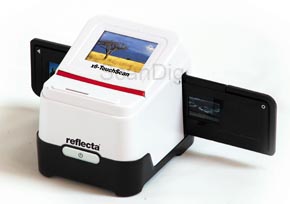
In the course of the time CMOS scanners have got features which formerly were only implemented in scanners. One such feature is the automatic scratch and dust removal function using an infrared channel. Up to now CMOS scanners are mainly placed in the low cost budget market. So it is hard to estimate which potential this technology really has. In spite of the restrictions in the image quality the CMOS scanners which are available on the market are quiete popular, since they are cheap, compact and easy to handle. At the digitalisation of less demanding originals like paper documents CMOS scanners have a time advantage compared to normal scanners. At demanding originals like slides one better uses classical scanners.
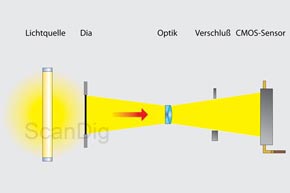
The adjacent figure shows the functional principle of a CMOS scanner: A slide which is inserted into the scanner is rayed from the left side by a light source. It is an artificial light source, since the natural light is not sufficient for a short exposure time. On the right side of the slide there are 3 components, which you may know from a digital camera: First the incoming light rays are captured by a lense system (optics), then they are bunched and focussed. At the moment of the triggering (pressing the scan button at the device or in the scan software) the closure opens (corresponds to the aperture of a camera) for a short moment, and the light rays which are captured by the optics get through the opened shutter to the CCD sensor which is behind it. Thus the shot, which is a photo of the inserted slide, is done and the internal singal processessing can calculate a digital image from the imput. This digital image can be seen at the display of the scanner or at the monitor within the scan software.
CMOS scanner photograph the inserted film. They are quite cheap. However, the image quality is so modest, that they are not suitable for archiving film material.
The Germany company reflecta was one of the first, which brought a CMOS scanner to the market, namely both for scanning slides and negatives and for digitizing small paper documents. Nowadays there are numerous CMOS scanners in the market, which are often produced by the same manufacturer, however are labelled differently. Even in large super market chains you can find CMOS scanners in their sales booths, partly for ridiculous prices.
No matter which brand is written on the case of a CMOS scanner, the devices are quite similar and differ just in the functionality. Generally the image quality is so bad that it is just sufficient for a quick scan, e.g. for integrating pictures on a website or for sending pictures to friends. For the digital archiving of a film archive CMOS scanners are not suitable.
CMOS scanners for 35m slides and 35mm negatives are available since 2007. A bit later CMOS scanners for paper documents were released. Since 2015 there is a CMOS scanner for medium formats from the manufacturer reflecta. In our film scanner shop you can find actual models from reflecta on CMOS basis.
Photographing slides with a digital camera
The actual CMOS sanners which are on the market are all low budget devcies, which are equipped with low cost components. If you want to digitize films with a CMOS sensors in better quality you have to build your own solution. Basically you can use any digital camera to take photos from slides and negatives. For a good quality, however, you need first-class equipment. High-class components like a full format SLR with marcro lense, a good illumination and suitable mounts are not cheap, but most of that mentioned equipment can be used for general photographing, too.
In the photo accessories business there are numerous slide holders and digitalization mounts, but no complete solution including software as you kwow it from any usual scanner. If you want to achieve very good results you have to put your own work in your system. Compared to high value film scanners a macro lense has a higher depth of focus, which is advantageous especially at slightly curved films. Image defects, which are not avoidable in the general photography, are not relevant in the close-up range of a high-value macro lense. Important is the exact alignment of the camera, on photos in the scale 1:1 even slightest alignment errors of the camera have a deep negative impact.
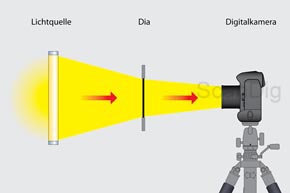
With an indirect illumination scratches and dust can be attenuated - similar to a diffusor, which is used at the approx. 20.000 € expensive scanner Hasselblad Flextight X5 - however, it is not an equal solution to the infrared based scratch and dust removal function at film scanners. So the manual retouching is more elaborate at this method compared to classical scanners. Furthermore, there is no special digitalization software for this special application. With Photoshop® you can principally do everything, however, it is very time-consuming. Especially for the digitalization of negatives a real scan software is much better than general eimage editing programs, since they have special film profiles included.
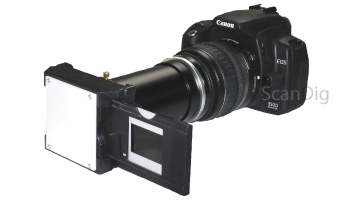
According to the actual state of the art CMOS area sensors are worse than CCD line sensors in terms of the dynamic range. This becomes noticeable especially at digitizing slides. Sooner or later digital cameras will catch up, since there is a lot of research and development spended in digital cameras compared to scanners. in one point the photographing method is leading: The speed is significantly higher compared to a classic scan. When the system once is set up and adjusted to one's demands, you can very quickly digitize large archives. With film scannners a better image quality can be achieved, however, the expenditure of time is significantly higher.
With a high-value digital SLR and a good composition you can make significantly better "scans" than with simple CMOS devices. The expenditure of time for the composition of the system, however, is high.
Taking photos of slides has never established itself really; complete solutions never could establish in the market, since god film scanners have become cheaper and better in the course of the years and still deliver better scans, especially due to the automatic scratch and dust removal functions, which is quasi standard. If you want to digitize negatives instead of positives, the photographing method is not suitable. The only device, which could establish itself on the market for a longer time is the HD slide duplicator from reflecta..
Flatbed scanners with transparency unit
The flatbed scanner is the Methuselah in the DEV. It was developed in 1976 by Ray Kurzweil in cooperation with the Bell-Laboratories. The first application was in the Kurzweil Reading Machine. For approx. 100.000 US-Dollar, which corresponded to a house in a suburb at that time, one got a device of the size of a washing machine. Even at the beginning of the Nineties a simple black/white flat bed scanner without transparency unit cost several thousand Mark. Since that time flatbed scanners have not only become much smaller but also significantly cheaper. Flatbed scanners basically can scan both reflective and transparent originals. If you look for a universal scanner you should take a flatbed scanner.
Flatbed scanners which are suitable for digitizing slides and negatives have a transparency unit integrated. Not all flatbed scanners have such a transparency unit; furthermore there are big differences between the singular models. For some flatbed scanners a transparency unit is only optionally available. Low-cost scanners often have a very small transparency unit, only at expensive models the complete scan area can be rayed. For a batch mode operation it is, however, important, that you can put as much as possible film strips or mounted slides on the glass surface of the scanner. The bigger the transparency unit is the more efficient you can work with the scanner.
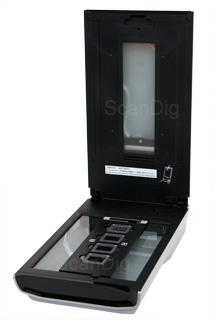
In the scan quality of transmissive film oroginals flatbed scanners do not achieve the standard of good film scanners. One reason is the glass surface on which the originals lie. Another deficit of flatbed scanners compared to film scanners is the much too low effective resolution (the manufacturers values usually are undercut significantly) and the much too low density range. Therefore with flatbed scanners it is possible, to scan also medium formats and large formats. This is especially interesting if you have a low budget available. Special scanners for medium format and large format films are extremely expensive, flatbed scanners are comparatively cheap.
If you compare the technical data of flatbed scanners with film scanners you will not notice big differences. However, there is a noticeable discrepance between the nominal and the effective resolution especially at flatbed scanners. Good film scanners like the Reflecta RPS 10M retrieve much more from an original that a good flatbed scanner like the Epson Perfection V850 Pro. Whilst the Reflecta RPS 10M achieves effectively 4300 ppi from a nominal resolution of 5000 dpi, the Epson promises 6400 dpi and delivers only 2300 ppi. At flatbed scanners you get extremely inflated files, in which every pixel is contained several times. It is a very time consuming task to downsize these infalted files in the image editing program after the scan procedure.
Up to the end of the last millenium there very very expensive high end flatbed scanners availalbe, e.g. from Heidelberg or Creo. These scanners achieved a better image quality, however the section of high end flatbed scanners has died out in the meanwhile. The only scanner which one might still consider as a high end scanner is the Epson Expression 12000xl Pro.
All in all flatbed scanners are ideal all-rounders if you want to buy only one scanner for all purposes. Of course they cannot catch up with the image quality of special film scanners, howevere therefore they have a multifunctional purpose and are comparatively low-cost.
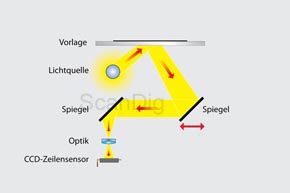
How does a flatbed scanner work? Two figures shall demonstrate this for reflective scans and transmissive scans. You know scanning of reflective originals (documents, photos etc.) from any copy machine: You put a document on the glass surface of the scanner and close the scanner lid, so that the document lies flat on the glass surface. Then a light source samples the document from the top to the bottom and rays it with light from the bottom. The reflected light rays are diverted by mirrorws, then from a lense system (optics) focussed and finally get to the CCD line sensor which converts light rays into electrical signals with the help of photo diodes. These electrical signals can be processed to a digital image from the signal processing unit in the scanner electronics. According to this principle all modern flatbed scanners and modern copy machines work (actual copiers are nothing else than a digital scanner in combination with a printer combined in one device).
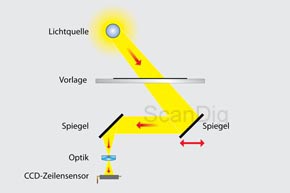
Compared to paper originals film material is transparent, i.e. light which comes from the bottom would not be reflected by the film material. For this reason flatbed scanners, which enable scanning of film material, need a transparency unit. That implies a light source which usually is integrated in the lid of the scanner. This rays the original (film material) from above, so that the light rays of the light source get through the film to the mirror system and the optics of the scanner to the CCD sensor. Additionally to the film material the light rays have to go through the glass plate of the scanner, which results in quality deficits, since it is usually not a high-value glass plate. The originals can be positives or negatives, the conversion of negative scans is done within the scan software.
Flatbed scanners need an integrated or optional transparency unit in order to digitize slides or negatives. The image quality does not achive the same level as real film scanners to, however usually exceeds that of simple CMOS scanners.
As already mentioned flatbed scanners are a good alternative for occasional scanning of negatives or slides. Since flatbed scanner belongs to the standard equipment of a PC desk you don't need additional space for another device. Thus you have only one device for scanning documents and films. In the field of flatbed scanners with transparency unit Epson has established as market leader in the course of the years. Epson scanners are available in our film scanner shop starting with the beginner's model V550 over several good or very good devices (V600, V800, V850) up to the above mentioned high end model Expression 12000xl Pro.
Film scanner (desktop area)
Film scanners are a quite new invention, they came up in the 1990s. At that time it was a revolution that press photographers could digitize their self developed films with a portable scanner. Before the coming up of digital SLRs scanning of developed films were the fastest way to hand over images to an editorial office. Compared to drum scanners which were used at that time in media companies the compact film scanners were much more handy in the desktop area.
In our film scanner shop there are numerous film scanners available from models for beginners to high end devices. Compared to flatbed scanners film scanners are specislists. Usually they are not only restricted to transmissive originals but also are hardly flexible in the film formats. In this device class the only standard is scanning 35mm films. Medium format films can be processed only by a couple of film scanners, and in the large format area one has to change to other scanner classes like Hasselblad scanners, flatbed scanners or even drum scanners. It depends on the individual scanner if exotic formats like APS or Minox are supported. You cannot expect that, so you should clarify that before the purchase. Sometimes for special film formats there are special adaptors necessary, which can be bought separately.
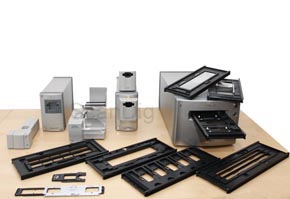
Film scanners are not predestinated for a multiple purpose. Therefore they score in the discipline which is essential: in the image quality. Top film scanners like the last Nikon series (5/5000/9000) can scan 35mm slides so detailed and brilliantly, that the difference to scans from flat bed scanners or CMOS scanners is essential. One disadvantage of the Coolscan series is the low depth of sharpness. Unfortunately there is no comparable film scanner from any other manufacturer which has a similar image quality with a larger depth of sharpmess. Better film scanners have an automatic transport of film strips integrated, even the batch processing of framed slides is sometimes possible.
Unfortunately there are only a few film scanner manufacturers left. Large companies, which are well known from the photo area like Minolta, Nikon or Canon have given up their film scanner production a long time ago. There are seldomly innovations in this market, and there is hardly a competition. Thus in the film scanner area there is a unique constellation in the fast moving IT business, that a device, which was introduced in the market in 2003 (Nikon Super Coolscan 5000) is still technically leading.
The investment in a film scanner is worth it, if you can do without a big variety but prefer an excellent image quality. Compared to flat bed scanners film scanners usually achieve a better image quality, and probably it will not change in the future. So film scanners are specialists with many advantages but also with deficits.
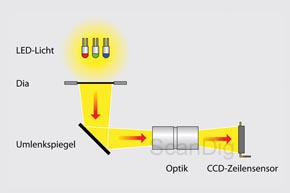
While a flatbed scanner is mainly built for digitizing paper originals and can be extend for scanning film material with the use of a transparency unit, a film scanner is not constructed for anything else than digitzing slides and negatives. Thus the whole system is optimized for that purpose. You do not find glass surfaces in film scanners, which might influence the image quality negatively. As light source usually LEDs are used. They have the advantage that thei hardly produce heat, so that there are no flipping effects like in slide projectors, where a hot lamp warms up the slides. The light which comes from the LEDs rays directly through the inserted positive or negative and is lead to the CCD line sensor with a passive reflector and the optics. On this CCD sensor there are thousands of photo diodes, which convert the incoming light into electrical signals and hand them over to the image editing processor. Compared to CMOS scanners the image is not sampled at a time completely but line by line. You find detailed information about that topic on our page about CCD sensors.
Film scanner distinguish themselves by a very high resolution, which is also achieved in practice by the very good devices. Furthermore they have a high density range so that the full dymanic range of a slide or negative can be captured. Almost all film scanners nowadays have an automatic scratch and dust removal function based on an additional infrared scan, so that the scans often are better than the original film.
Film scanners are built especially for digitizing slides and negatives. Thanks to their high resolution and their high density range and the hardware based dust and scratch removal function theiy achieve an image quality which exceeds most flat bed scanners and any CMOS scanner.
A good film scanner like the Reflecta CrystalScan 7200 is available for only approx. 250 Euro; there are hardly any limits in higher prices.
Film scanner (Photo laboratory area)
If one talkas about film scanners ususalle desktop devices area meant, which are used both from photo amateurs and from scan services. Besides them there are dedicated scanners for use in photographic laboratories, which are also sold as film scanners. Differently to desktop scanners those laboratory scanners are built for maximum productivity. In a photographic laboratory time is essential, otherwise no money is earned.
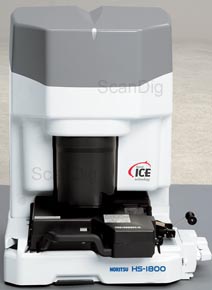
Digitizing films in photographic laboratories is standard since the 1990s. You hardly can find an analogue work flow in any photo laboratory. Scans from photos, which are produced as photo CD additionally to classical prints, don't have a good quality. Mostly they are JPG files with low resolution, which restricts the further use of the images drastically.
There are special film scanners for photographic laboratories, e.g. from the manufacturers Noritsu or Fuji. They can digitize originals in good quality and high resolution, however, the image quality depends strongly from the carefulness how the machine has been configured. Also there are essential differencies between the particular scanner models. The resolution is in a similar field as at desktop film scanners, an automatic scratch and dust removal function is standard in the laboratory scanners.
If you look for further information on the manufacturer's websites, e.g. from Noritsu, you will hardly find anything. In this market segment the throughput per hour seems to be the sole criterion, dynamic range and optical resolution are often not given explicitly. So a direct comparison with desktop scanners is hardly possible, above all there are hardly any tests of laboratory scanners available.
For the home use this device class is clearly overdimensioned, especially since the costs of acquisition lie in the 5-digit area. Similar to deskto pscanners the scan quality dependes from the used scanner model. While it is quite simple to classify a desktop scanner in terms of quality, for a photographic laboratory scanner expert know how is necessary. One reason is the poo information policy of the manufacturers.
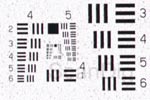
An interesting question is which resolution such a laboratory scanner achieves in practice. We have scanned a USAF-1951 test chart with a Noritsu HS-1800. The maximum nominal resolution in the 35mm field is 4790 dpi. The adjacent image shows the inner part of the scan. You can recognize the 3 bars of the element 6.4. This corresponds to an effective resolution of approx. 4600 ppi according to our resolution chart. This is an excellent value and proves that the Noritsu HS-1800 achieves in practice what it promises, namely approx. 96% of its nominal resolution, which is an excellent value.1)
So the Noritsu HS-1800 delivers a very high effective resolution; it exceeds most film scanners which are available on the market. Only the scanners from Hasselblad and some drum scanners achieve higher resolutions in practice.
A scanner like the Noritsu HS-1800 is no device for a (rich) private person: You recognize this at the elaborate installation procedure: You don't just insert a DVD with a driver in your PC, but you send your PC to the manufacturer, which does the installation and calibration for you. Thus it is no easy to handly consumer device but a laboratory device with different requirements than in a home office.
Drum scanner with photo multiplier technique
Drum scanner are the oldes device class among the scanners. Even in 1963 Rudolf Hell demonstrated his Chromagraph. At that time computers could hardly be found in companies, magazines were made manually. Different to state of the art drum scanners the Chromagraph was not able to convert an analogue film into a digital image. Instead this device produced colour separations for prints, i.e. an analogue variant of the original. This changed in the course of decades, the drum scan principle was later used for the analogue-digital-conversion.
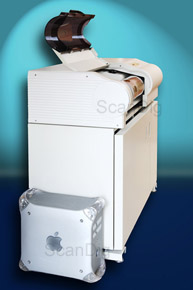
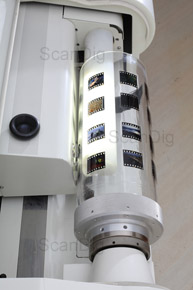
Drum scanners were and are still extremely expensive devices for use in enterprises. As a rough value you should calculate at least 30.000 € for a new device. Today you cannot buy a new device any more. After their blooming period in the 1990s the upcoming digital photography brought the end of drum scanners. After the turn of millenium the market for drum scanners shrinked rapidly. Big manufacturers like Heidelberg, Crossfield, Screen, Scan View, Isomet, Optronics, Fuji and Scitex have given up their production meanwhile. New devices are only available from Aztek and ICG, in both cases it seems to be a sale of the stock.
Drum scanners of the early generations had a weight like a small car, since they needed big centrifugal masses for the stabilization of the rotating drum. Modern devices (which are not necessarily better) are much more light weight and can be placed on a work desk or can be put up as an own work station including operational unit, compare our photo of a Dainippon Screen DT-S1045ai.2)
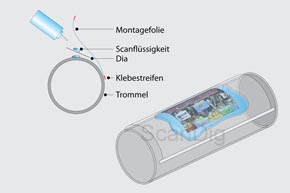
The use of such devices is very complicated. First the film originals have to be fixed on the transparent drum with tapes - a very time consuming process for each single picture. By the use of scan fluid Newton rings are avoided. For sensitive or non bendable films drum scanners are not suitable. However, this mounting technique makes sure that the film lies absolutely flat on the drum, which is ideal for the scan. Usually the drum is filled completely with film material before the scan is done for all filmes on the drum at a time. While the scanner samples picture by picture a second drum can be filled with film originals in order to achieve an effective work flow.
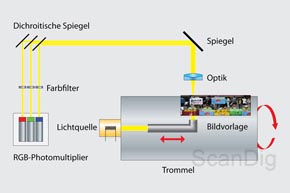
How does a drum scanner work? A light source in the drum rays the film on the exterior surface of the drum. Via a lense system and a mirror system the transmitting light is fed to the photo multipliers. Colour filters filter the light into a red, a green and a blue part, which is measured by singular photo multiplier elements. Photo multipliers are much more sensitive than photo diodes used in conventional CCD sensors, since photo multipliers amplify their effect by cascading dynods. For this reason photo multipliers can convert smallest light amounts into measurable electrical signals and thus have a much higher dynamic range than CCD sensors or CMOS sensors.
The complete image area of a film on the drum is sampled pixel by pixel. Therefore the scan head, which includes the optices and the conversion mirrors, moves in longitudinal direction; the horizontal movement is given by the rotation of the drum.
The effective resolution of drum scanners is much higher than the one achieved by film scanners. 12.000 ppi or more can be achieved with this technique according to the manufacturer's data. At film film scanners the maximum value lies at approx. 4.500 ppi at the moment. In practice these extremely high resolutions are hardly useful. On the one side you create extremely big image files: A 35mm slide scanned with 12.000 ppi and 48 bit colour depth as 1 Gigabyte in the uncompressed TIF format. On the other side only high class films justify such a high resolution.

CMOS-Scanner, flatbed scanner and simple film scanner all have in common that they achieve a lower resolution in practice than the manufacturer promises. How is this at drum scanners? The adjacent picture shows the scan of a USAF-1951 target with a Dainippon Screen DT-S1045ai drum scanner, built in 1995. The scan was made with the nominal resolution of 8000 dpi3). As you can see in our resolution chart, this scan has an effective resolution of only 4000 dpi; this corresponds just 50% of the nominal resolution. Resolution tests with 2 other drum scanners Screen DT1045 from Dainippon lead to the same result.

In an additional resolution test we have checked the resolution of a drum scanner ICG 3703). The adjacent picture shows the interior part of a USAF-1951 target, which was scanned with a nominal resolution of 12.000 dpi. A comparison of the scan of the ICG 370 with the scan of the Screen 1045 shows immediately that the image is sharper, so it has a higher resolution. According to our resolution chart we find a sensational resolution of 6000 dpi. Anyway, like at the Dainippon Screen DTS1045ai also the ICG 370 achieves only approx. 50% of its nominal resolution in practice.
These results are disappointing like the measurement results of many flat bed scanners or low-cost film scanners. At the big Hasselblad Flextight X5 we have measured a resolution of 6900 dpi. Thus the Hasselblad Flextight X5 remains the absolute leader in terms of resolution. However, it has to mentioned that the Hasselblad Flextight X5 achieves this maximum resolution only in the 35mm field. At higher film dimension this resolution reduces up to 2040 dpi for constructional reasons. A drum scanner, however, which achieves 4000 ppi or even 6000 ppi effectively, brings this resolution also for large format scans and thus is the resolution leader in this field.
Drum scanners are very flexible in terms of different film formats. From the 35mm fromat to any large format, hardly anything can be scanned. The original size ist just limited by the drum size. The expensive hardware and the high work effort make the scan prices very high. Youu should calculate with approx. 50 € for a 35mm scan. Depending on the resolution this price my go up significantly, since for drum scans you usually pay according to the data volume created.
Drum scanners distinguish themselves by a very high resolution and an extremely good dynamic range. They can digitize any film material, which can be placed on the drum.
Also if you can find cheap offers at ebay, we do not recommend to buy a drum scanner for home use. These scanners are too complex. If a professional scanner operator does his job, the image quality of a drum scanner is still superior to any other digitalisation method. Additionally to the high scan costs a high retouching effort is necessary compared to film scanners. An infrared channel for an automatic dust and scratch removal is not available for drum scanners, retouching is manual work. This process is not suitable for digitizing larger image archives. If you want to get scans from singular slides in perfect quality, the drum scan procedure is a god option. However, you have to pay a big price for that service.
Virtual drum scanners (Hasselblad scanners)
Virtual drum scanners have originally been developed by the Dutch company Imacon; the Swedish camera producer Hasselblad has taken over this brand later. Thus Imacon scanners are the predecessor of the actual Hasselblad Flextight scanners.
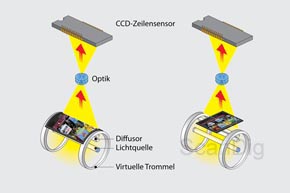
The scan procedure is based on the principle of a virtual drum. Before the scanning the films are put into a glassless magnetic mask. This mask bends during the scan so that a virtual drum form exists. Compared to classical line scanner which scan the films flatly a better flatness is achieved. Curvatures of the films are compensated by the bending. This is especially important in the medium format and large format field. Of course the accurate alignment of a professional served drum scanner is not achieved with the Hasselblad procedure, however this procedure is not only much more time effective but also gentle to the films. In a Hasselblad scanner the important part of the film is in the air, and that is important like at convential film scanners.
Hasselblad Flextight scanner are capable to scan mounted slides in batch mode using a special feeder. However, you have to consider, that the principle of the virtual drum does not work, since mounted slides cannot be bended. Thus you can do without unframing them, however you do not benefit of the bigger depth of focus by the virtual drum. At mounted slides the Hasselblad Flextight scanner works in the same way as conventional film scanners.
Up to now there is no Hasselblad scanner with an infrared channel. So a hardware based scratch and dust removal function is not possible with thouse scanners. However, the top model Hasselblad Flextight X5 has a light condenser. Thanks to an indirect illumination dust and scratches are less visible on the scan than by direct illumination like in the Hasselblad Flextight X1. Both the beginner's model from Hasselblad an most other film scanner work with a direct illumination. So at Hasselblad scans you always have a higher retouching effort compared to other film scanners which correct films automatically with Digital ICE or similar functions.
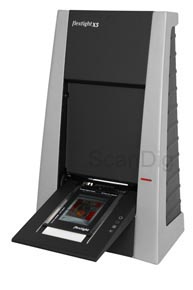
Hasselblad scanner can process transparent and reflective originals up to a size of 10,0 x 24,5 cm. With these dimensions they can be used much more flexibly than conventional film scanners. In terms of the effective resolution the Hasselblad scanner exceed all other film scanners on the market. At a nominal resolution of 8000 ppi they can achieve 6900 ppi in practice.
Considering the resolution there is a peculiarity of the Hasselblad system to consider. The distance of the CCD line sensor and the film varies in dependence of the film size. So the nominal resolution is 8000 ppi at 35mm scans, for medium forat films 3200 ppi and for large format films only 2040 ppi. You can neglect that because the larger film formats have more quality reserves to to the larger scan area. Furthermore the high resolutions lead to extremely large image files. A 60x60mm medium format film produces at 16 bit TIF 436 Megabyte of data. This amount is usually more than sufficient.
Hasselblad scanners are not so expensive like drum scanners, however, the purchase costs lie in the range of a small car. The missing automatic scratch and dust removal function is a deficit in the 35mm field. In this area Digital ICE or similar methods are standard and an essential feature especially when digitizing masses of film material. Hasselblad scanners are mainly built to scan medium format films and large format films. Here the concept of the virtual drum is advantageous. Hasselblad scanners have the additional advantage that they are comparable easy to handly and so are cheaper to oprate compared to drum scanners. An additional benefit is the mild treatment of the films.
Hasselblad Flextight scanners distinguish themselves by a very high resolution and an excellent colour reproduction. Although they have no automatic scratch and dust removal function, they can be designated as the top moels in the film scanner area nowadays.
The price for a Hasselblad scanner is in the range of 10.000 € and 25.000 €. There is a large Hasselblad accessories assortment, so that almost any film type can be scanned with the Flextight scanners. While the opration of a drum scanner required a special profession, the use of a Hasselblad scanner can be learned like the operation of a simple desktop scanner.
1) Tnaks to Mr. Ulrich Schnarr from the company Fotospeed from Vienna, who has made the resolution test for us.
2) At this point many thanks to Mr. Josef Seitz from Krumbach for the pictures of the drum scanner Dainippon Screen DT-S1045ai and the resolution scan.
3) Thank you Mr. Janusz Zalasa for making this scan with his drum scanner ICG 370 for us and for making the resolution test with a Dainippon 1045ai for us.
Back to the index Know How
|